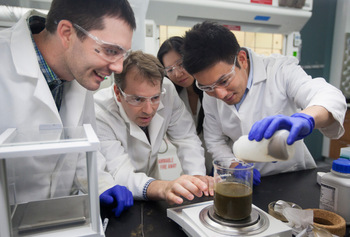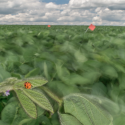Helping Wisconsin dairy farms produce ‘brown gold’
In the heart of Wisconsin, a project is underway to produce energy from a resource in little danger of running low: cow manure, also known as “brown gold.”
Although some manure can be used as fertilizer, nutrient imbalances and pollution caused by manure runoff can create environmental problems. Large dairies produce up to 25 tons of manure each day, which requires millions of gallons of water to manage.
Thanks to a $7 million grant from the United States Department of Agriculture’s Biomass Research and Development Initiative, researchers from the University of Wisconsin–Madison have partnered with several Wisconsin companies to form a consortium that is piloting new methods for turning dairy farm manure into useful products.

Jamison Watson, Troy Runge, and Kim Huong Pham examine a manure sample being prepared for separation by Zong Liu.
Photo: Matt Wisniewski
The consortium’s first major project, the Accelerated Renewable Energy Project (ARE), has already been implemented at Maple Leaf Dairy, located in Manitowoc County. Home to 5,000 cows, the dairy is helping UW–Madison researchers study manure processing techniques and technologies that could also benefit other Wisconsin dairies.
ARE co-investigator and biological systems engineering Assistant Professor Troy Runge says the project presents an opportunity to support a renewable energy economy, while developing value-added products from biomass. Housed within the Wisconsin Energy Institute at UW–Madison, Runge’s lab is analyzing separation techniques to improve efficiency and economic performance. As part of the project, researchers have assessed a variety of manure separation systems, and they’ve found that even simple, low-cost systems can recycle the water involved in processing manure and help manage nutrients.
“This is a great example of a multidisciplinary public-private partnership happening right here at the Wisconsin Energy Institute,” says Runge. “It’s also an example of a project that is important to Wisconsin.”

Aicardo Roa-Espinosa
After small plant fibers in the manure are separated out and anaerobically digested to create biogas, liquids from the digestion process are used to fertilize crops, while leftover solids are converted into useful chemicals and bioplastics. The larger plant fibers can be used for animal bedding and mulch or as starting material for ethanol fermentation.
Runge works closely with Aicardo Roa-Espinosa, the president of SoilNet LLC and a biological systems engineering adjunct faculty member. Roa-Espinosa developed the technology behind the manure separation system that drives the ARE project. Along with Runge, Roa-Espinosa monitors the quality, quantity and composition of biogas produced from fermented manure from Maple Leaf.
These separation systems could have the potential to help farmers better manage manure and to use it in ways that benefit soils, the environment and human health. For example, the project’s new approach to manure separation also yields fertilizer that is more concentrated and homogenized, allowing farmers to apply it with much greater precision and control over nutrient content. This method not only improves crop fertilization and limits pollution, but it also recycles water.
“We would like to make money by doing the right thing by the environment and society.”
Tom Cox
The cellulosic — or nonfood — plant biomass that is derived from dairy manure could also mean that dairies could eventually become cellulosic biorefineries.
“This is a triple-win situation,” says project collaborator Tom Cox, a professor of agricultural economics in the College of Agriculture and Life Sciences. “We would like to make money by doing the right thing by the environment and society.”
—Celia Luterbacher
Tags: agriculture, energy, research



